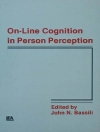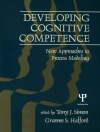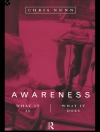‘The authors’ choice of key elements results in a book that provides knowledge essential for beginning counselors to learn and for experienced counselors to reviewÖ. Consequently, The Elements of Counseling Children and Adolescents should be useful for students in the helping professions, includingÖpsychology, social work, and counseling.’
óFrom the Foreword by Scott T. Meier, Ph D, coauthor, The Elements of Counseling
‘Offers precise, practical guidance based on a proven teaching format.’
Tailored to the specific needs of the child and adolescent client, this concise, easy-to-read primer provides essential and practical guidelines for counselors and psychologists who are training to work with children in both clinical and school settings. It is modeled after the highly successful and time-tested ‘Elements ofÖ’ format used in many teaching disciplines. The book distills the basic concepts that beginning professionals must keep in mind as they approach practice, offering guidance in a logical, numbered sequence from setting the stage for the counseling process through the essentials of building and maintaining an active counseling practice.
In addition to facilitating learning with its precise, easily understood rules and principles, the book provides potent guidance for both common and challenging situations. Key concepts such as using developmentally appropriate language and activities are covered, along with critical issues such as collaborating with parents and other professionals, responding to crisis situations, and counselor self-awareness and self-care. Case examples of clientñcounselor dialogues in each chapter illustrate foundational concepts, and an overview of how to use the text for transcript analysis in training programs is also included. Written by experienced counseling and therapy educators and professionals, this versatile text will be a welcome addition for courses in counseling children and adolescents as well as other courses across the curriculum in school counseling; school psychology; marriage, child, and family counseling; and clinical social work.
KEY FEATURES:
- Distills the essential components of therapy and counseling with children and adolescents in a highly useful, time-tested ‘Elements ofÖ’ format
- Adaptable to a range of counseling-related courses across the curriculum
- Provides illustrative examples of counselorñclient dialogues
- Includes instructor’s manual
Cuprins
‘
Foreword by Scott T. Meier, Ph D
Preface
Acknowledgments
Chapter One Setting the Stage
1. Initial Contact
2. Respect Caregivers and Family Members in the Process
3. The First Appointment
4. Share Your Background
5. Explain Counseling
6. Provide an Overview of Guidelines
7. Address Confidentiality and Privacy
A. Privacy Between Child and Caregiver
B. Privacy Rule
8. Begin to Explore the Client’s Story and Create Counseling Goals
9. Create a Developmentally Accommodating Office Space
10. Be on Time
11. Individualize Counseling
12. Meet Your Client’s Age and Developmental Level
13. Developmental Framework
14. Address Resistance, Create a Working Alliance
15. See the Big Picture
Summary and Discussion Questions
References
Chapter Two The Processes of Counseling With Children and Adolescents
16. Reflect First (Content, Feeling, and Meaning)
17. Focus on Feeling
18. Summarize
19. Reflect the Process
20. Speak Briefly
21. Allow and Use Silence
22. Use Open-Ended Questions
23. Confront Effectively and With Care
24. Use Developmentally Appropriate Language
25. Be Concrete
26. Match the Strategy or Technique to Processing Level
27. When Words Fail, Draw or Play
28. Use Stories and Metaphors
Summary and Discussion Questions
References
Chapter Three Strategies for Assisting Self-Awareness and Growth
29. Reflect and Give Time for Processing (Do and Do Not Do)
30. Avoid Giving Advice
31. Avoid Relying on Questions
32. Listen Carefully to the Words Used
33. Focus on the Client
34. Pay Attention to Nonverbals
35. Ground Feelings in the Body and Teach Distress Tolerance
36. Pause and Reflect Themes/Enumerate Topics
37. Use a Problem-Solving Model
38. Set Clear, Measureable Goals
Summary and Discussion Questions
References
Chapter Four Misconceptions and Assumptions
39. Do Not Assume That Change Is Simple
40. Academic Developmental Level Does Not Equal Emotional Developmental Level
41. Agreement Does Not Equal Empathy
42. Avoid Moral Judgments
43. Saying They Understand Does Not Mean That They Understand
44. You Can’t Assume That You Know (Feelings, Thoughts, and Behaviors)
45. Do Not Assume That You Know How Clients React to Their Feelings, Thoughts, and Behaviors
46. Do Not Assume That All Interventions Will Be Safe or Appropriate for All Clients
47. Positive and Rational Thinking Are Not the Same
Summary and Discussion Questions
References
Chapter Five A Brief Introduction to Evidence-Based Practice and Contemporary Interventions
48. Be Familiar With Limitations of ESTs With Children and Adolescents
49. Practicewise Clinical Decision-Making Support
50. Contemporary Psychotherapy Interventions With Children and Adolescents
A. Brief, Solution-Focused Therapies
B. Cognitive Behavioral Therapy
C. Trauma-Focused Cognitive Behavioral Therapy
D. Behavior Therapy
E. Play Therapy
F. Family Therapy
G. Creative and Innovative Techniques to Enhance Evidence-Based Interventions
H. Multisystemic Therapy
51. Consider Integrative Approaches
Summary and Discussion Questions
References
Chapter Six Crisis Intervention, Mandated Reporting, and Related Issues
52. Develop Crisis-Intervention Skills
A. Assess for Suicide Risk: Specificity-Lethality-Access-Proximity-Prior Attempts (SLAP-P)
B. Take Control of the Situation
C. Focus on Competencies and Strengths
D. Mobilize Social Resources and Engage Caregivers
E. Know and Use Community and Technology Supports
53. Learn and Understand Grief, Loss, and Trauma
54. Become Literate in Mandated Reporting
A. Know Your State Laws and Nomenclature
B. Consider a Probability Threshold
C. Use Framework Proposed By Levi and Portwood (2011)
D. Be Prepared for Reactions and Seek Supervision Appropriately
55. Refer Carefully
Summary and Discussion Questions
References
Chapter Seven Knowing and Caring for Yourself as a Counselor
56. Begin With Self-Awareness
A. Why Did You Choose Counseling as a Career?
B. Be Aware of the Emotions and Topics That Challenge You
C. Know When You Are Impaired
D. Know the Signs of Burnout and Compassion Fatigue
57. Get the Support and Supervision You Need
A. Create a Support Group
B. Supervision Leads to Competence
C. Get Personal Counseling
58. Have Good Boundaries
A. Practice Disengagement
B. Establish and Keep Physical Boundaries
C. Create and Maintain a Manageable Schedule
D. Practice Within Your Competency
E. Accept That Clients Grow at a Pace That Makes Sense for Their Mental Health
59. Engage in a Consistent Practice of Self-Care
Summary and Discussion Questions
References
Appendix: How to Use This Book in Training
Counselor-in-Training Instructions
Index
‘Despre autor
Laura M. Anderson, Ph D, is an assistant professor and director of the PULSE Healthy Weight Research Team at the School of Nursing, University at Buffalo. She is also a licensed psychologist.












